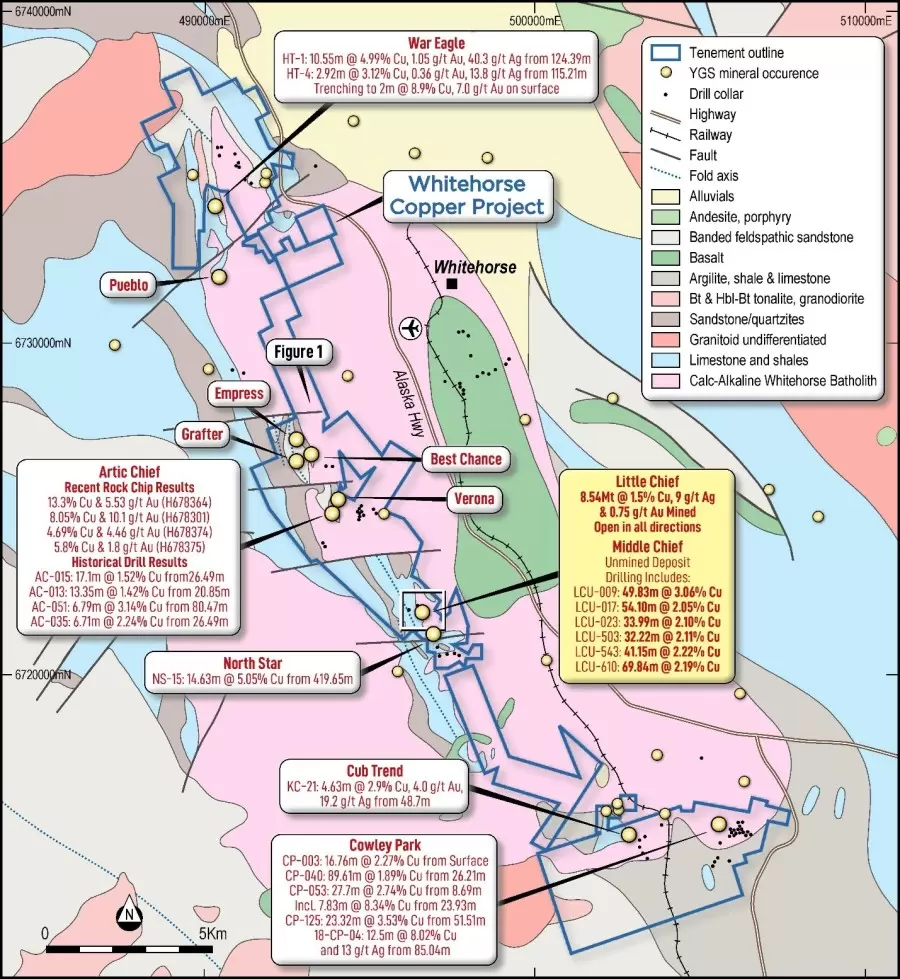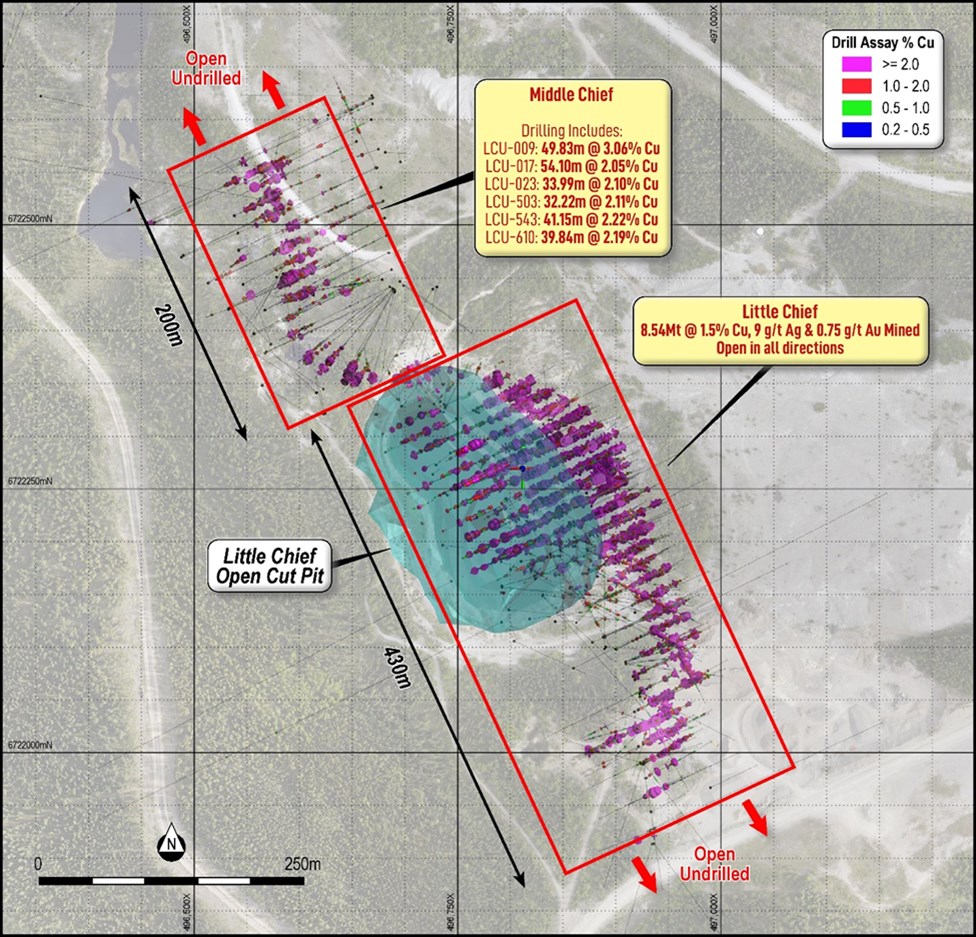
Gladiator Metals (TSXV: GLAD) has announced an update on its data compilation and exploration efforts at the Whitehorse Copper Project. This update includes the discovery of significant, unmined Copper-Gold skarns over a 700-meter strike at the historic Little Chief mine trend.
Gladiator CEO Jason Bontempo commented in a press release: “With the identification of the Middle Chief mineralization Gladiator continues to define areas of high-grade copper skarn mineralisation with significant exploration upside from its data compilation of historic drilling datasets. The Middle Chief mineralization represents a near-surface area of mineralization open in all directions with limited exploration or development away from historical underground infrastructure. Historical drilling and past production from the Little Chief mine area as a whole remains shallow, and this data compilation represents an opportunity to review the deposit in 3D for the first time to begin to appreciate the exploration potential of the high-grade copper-gold skarn, which remains open in all directions, for future resource growth. Planned diamond drilling is scheduled to commence in the coming months and will be testing the Middle Chief target as well as near mine extensions to the historic Little Chief mine.”
The Little Chief Mine, along with the Middle Chief Target, forms part of the Whitehorse Copper Belt. The Little Chief Mine, historically the largest producer in this area, yielded around 8.54 million tonnes of ore with a copper grade of over 1.5% and 0.75g/t gold, according to a 1984 report by Watson. Mining operations at Little Chief began in 1967 and concluded in 1982, influenced by the low copper prices at the time. Gladiator’s recent review suggests the potential for further mineralization at deeper levels, previously unexplored by drilling.
Gladiator has been actively compiling and reviewing historical drilling data from the Little Chief mining area. This includes a LIDAR survey, reconnaissance, and sampling around the historic mine site. The results confirmed significant mineralization, initially identified in drilling from the decline of the old Little Chief underground mine, with additional drilling occurring before the mine’s closure in 1982.
David Tenney in 1981 reported underground reserves at Little Chief and Middle Chief that had remained unexplored. Gladiator’s analysis of historical drilling data has now identified a significant body of shallow mineralization, named the Middle Chief mineralization. This body, over 200 meters in length and located 120 meters below the surface, lies beneath the decline and north of the Little Chief Open pit and underground mine. It appears largely intact, with limited drilling scope to date.
The historical drilling data, comprising 628 underground and 166 surface holes, covering a total of 68,940 meters, had not been previously reported by Gladiator. It highlights substantial unmined mineralization.
For the first time, Gladiator has been able to review and model this mineralization in three dimensions, providing a new perspective for targeting further mineralization. The company plans to utilize modern geophysics techniques, including down-hole electromagnetics (DHEM), in its exploration.
Gladiator intends to commence exploration drilling at Middle Chief in the coming months, following a recently approved Class 1 exploration notification. This will be accompanied by DHEM surveying to identify undrilled extensions to the mineralization.
At the same time, Gladiator is conducting a high-resolution drone-borne aeromagnetic survey over the Little Chief area. The company plans to process the magnetic data and complete a three-dimensional inversion model, important for targeting the Magnetite enriched Skarns associated with historical mineralization.
Gladiator also plans to broaden its assay scope in future drilling and sampling, including testing for gold, silver, and molybdenum, which were significant contributors to the economics of the historic Little Chief operations.
The historical drilling data, obtained from the Yukon Geological Survey archives, has been incorporated into an industry-standard database by Gladiator. This comprehensive compilation and analysis marks a significant step in Gladiator’s ongoing exploration and development efforts in the Whitehorse Copper Project area.

Highlights from the results are as follows:
- Recent collation of historic data identifies the Middle Chief prospect a significant highly prospective unmined zone of mineralisation, commencing from 120m below surface at the northern extent of the former Little Chief open cut and underground mine at the Whitehorse Copper Project, including:
- LCU-009: 49.83m @ 3.06% Cu from 70.26m
- LCU-017: 54.10m @ 2.05% Cu from 77.42m
- LCU-023: 33.99m @ 2.10% Cu from 148.89m, Incl. 15.24m @ 3.26%Cu
- LCU-503: 32.22m @ 2.11% Cu from 83.91m, Incl. 17.07m @ 3.47% Cu
- LCU-543: 13.72m @ 1.28% Cu from 66.14m and 41.15m @ 2.22% Cu from 87.48m
- LCU-610: 50.99m @ 1.87% Cu from 18.11m, Incl. 39.84m @ 2.19% Cu from 23.16m
- High grade copper skarn mineralisation at Middle Chief remains open in all directions. Unmined historic resources were established, and drilling completed just prior to the closure of the Little Chief mine in 1982, due to the prevailing low copper prices at the time.
- Approval has now received from the Yukon Department of Energy, Mines and Resources (EMR) for a Class 1 exploration permit allowing up to 10,000 metres of diamond drilling, to test the Middle Chief prospect area and extensions to mineralisation at the Little Chief historical production area.
- Compiled historical drilling data is limited to selective sampling and assaying for copper only. Gladiator intends to assay all future drilling and sampling for additional credits including Molybdenum, Silver and Gold which were proven contributors to the economics of historic operations.



 Follow us on Twitter
Follow us on Twitter Become our facebook fan
Become our facebook fan










Comments are closed.